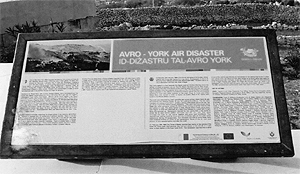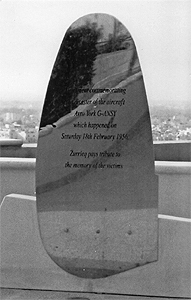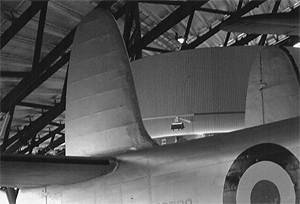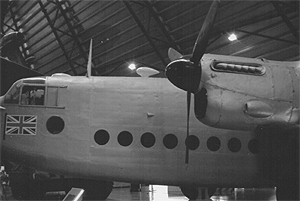
MALTA AIR DISASTER
| Date: 18th February 1956 | Time: 12:23 UTC |
| Type: Avro 685 York C.I. | Operator Scottish Airlines |
| Registration: G-ANSY | First Flight: 1945 |
| Departure: Malta-Luqa Airport | Destination: London-Stansted |
| Fatalities: 5 Crew - 45 Passengers | Damage: Written Off |
| Statistics: 70th loss of a Avro York The worst accident involving a Avro York (at the time) | |
Court of Inquiry Report:
The aircraft, owned by Scottish Airlines (Prestwick) Ltd., was purchased from the Royal Air Force in 1954 and was put in service after being overhauled and coverted by the company. According to the inquiry report, when the Avro York, which had arrived in Malta on the same day, took off from Luqa airport on its flight to Stansted, Capt. Coker, 40, of Prestwick, was cleared to turn right after take off. The actual take-off appeared to be perfectly normal. But moments later black smoke was seen to come out of the outer port engine No. 1
Instead of turning to starboard, as instructed by ground control, the plane drifted to port. The port wing later dipped steeply and the aircraft nose-dived into the ground near Zurrieq, straddling two fields and blowing up. All the occupants died instantly.
The probable cause was failure of No. 1 engine due to cracks in the boost enrichment capsule which resulted in a fire. But, the report adds, this failure alone did not cause the accident. Another factor was loss of speed and consequent loss of control through an error of judgement – failure by the captain to stop the leftward swing of the aircraft using the rudder and to correct the nose high attitude and feather No. 1 engine.
The altitude reached by the aircraft was sufficient for manoeuvring but the pilot failed to depress the nose of the aircraft in order to gain flying speed and directional control. The Court of Inquiry had kept in mind the possibility that Capt. Coker may not have feathered the propeller because he was still hoping to get some power from No. 1 engine, but it was considered that, in any case, he should have felt the drag on the rudder controls, particularly as the drag was being progressively accentuated by the diminishing directional control and by the ever-increasing approach to minimum control speed and stalling range. Moreover, the boost gauge should have indicated conclusively that no power was being derived from the faulty engine.
It should be added that, even if it were to be assumed that the pilot, for some unaccountable reason, had been unable to feather the propeller the aircraft would still have been capable of a three-engine performance. According to the evidence before it, the court observed that although the captain had been trained in his routine emergency check test to take off with an engine failure, the test had been carried out not at the all-up weight of 68,000 lbs but at a lesser weight of 55,000 to 57,000 lbs.
As the pilot received the message from local air traffic control that black smoke was coming out of No. 1 engine, at first there was no reply and as the call was repeated the aircraft immediately replied “Stand by” meaning that the pilot was busy and was not ready to accept a message. No further communication was received from the aircraft.
In its report, the Court of Inquiry said evidence confirmed that the aircraft climbed in steps at a slow forward speed, flying in a fail-down, nose up attitude and with varying degrees of smoke emanating from No.. 1 engine. Shortly after passing over Orendi village, the aircraft began to turn to port towards the southeast. At this point the aircraft was observed to be flying normally except that the engines seemed to have tremendous power and their vibration was felt by the driver of a car below. Shortly after, the Avro York was observed to falter in the air, its wings tilting both to port and starboard before finally dropping the port wing and turning over into a dive.
The Court of Inquiry also investigated the possibility of sabotage action but remarked that evidence in that direction was insufficient and consequently it was unable to conclude that the aircraft was subjected to any such action.
The bodies of the co-pilot, the navigator, the radio officer and an air hostess
were taken to the UK for burial, all the others are buried in Mtarfa.
Twelve victims had ‘Won Trip’
Twelve of the RAF victims in the crash had won places on the aircraft in a “lucky draw” at their station in the Suez Canal Zone. On February 20 of that year, the Times had reported that the father of one of the victims has received a letter from his son saying he was one of the lucky 12 personnel from his unit whose names had been drawn out of a hat to fly home rather than make the long trip by sea.
Among the crew of the doomed Avro York were first Officer, Robert Gorvin, 30, of Cowplain, Hants and air hostess, Jill Upham of Chalfont St. Peter, Bucks who were engaged and were to have been married some weeks later in Easter.
In time, the crash site was cleared of all traces of the fierce fire that raged
as 2,000 gallons of high octane aviation fuel spread over the crash site on
impact.
MALTA AIR CRASH CASUALTY LIST –
18th FEBRUARY 1956
Please Take A Minute To Remember Them
| Service No. | Rank | Initial | Name | Home Town |
| 592449 | Sgt | B | Alberyy | Weymouth |
| 4014297 | LAC | A | Barbour | Glasgow |
| 2721129 | Cpl | P | Bly | Lincs |
| 4111464 | Cpl | J | Bracewell | Bradford |
| 4122086 | LAC | D | Brown | Dundee |
| 1978756 | Cpl | C | Burke | Dublin |
| 4081381 | LAC | S | Butchart | Inverness |
| 4084971 | LAC | P | Carlton | Halifax |
| 4070082 | Cpl | J | Collier | Rhondda |
| 1922778 | Cpl | J | Cox | Norbury |
| 4076740 | Cpl | G | Craigee | Dundee |
| 2718862 | SAC | T | Dumbill | Liverpool |
| 2718503 | LAC | T | Drury-Lowe | Horley |
| 4091828 | Cpl | R | Edwards | Kidderminster |
| 4116734 | Cpl | J | Fawcett | Ipswich |
| 4080588 | LAC | Fitzpatrick | Manchester | |
| 4079838 | AC.1 | M | Fleming | Wexford |
| 4079955 | LAC | W | Fleming | Belfast |
| 351122 | Flt Sgt | H | George | Carlisle |
| 4092401 | LAC | R | Hampson | Denbigh |
| 4082027 | LAC | E | Harris | Kimbolton |
| 3142934 | SAC | S | Hodson | Mkt Harborough |
| 4125984 | LAC | J | Holiday | Worcester |
| 4084173 | LAC | F | Keating | Norbury |
| 4099286 | LAC | G | Kenyon | Co. Durham |
| 1923587 | Cpl | J | Mackay | Perth |
| 4129461 | LAC | D | Millar | Dundee |
| 4122093 | LAC | M | Nurse | Cardiff |
| 4090130 | LAC | D | Parker | Leicester |
| 2718806 | Cpl | A | Patison | Glasgow |
| 3513692 | Cpl | B | Pratchett | Parkeston Quay |
| 3513124 | LAC | M | Pye | Worcester |
| 4125466 | Cpl | T | Roberts | Worthing |
| 4010658 | Sgt | J | Spence | Loughborough |
| 643611 | Sgt | J | Spencer | Dagenham |
| 2558097 | Cpl | W | Steven | Glasgow |
| 4104881 | Cpl | W | Talbot | Didcot |
| 4129185 | Cpl | R | Waring | Lancaster |
| 4091991 | LAC | W | Welch | Falkirk |
| 4125725 | LAC | K | Williams | Liverpool |
| 4004177 | Cpl | R | Williams | Smethwick |
| 4091342 | LAC | J | Wilson | St. Andrews |
| 4115681 | SAC | G | Wortley | Wolsingham |
| 4130204 | AC.1 | R | Young | Aberdeen |
| 23060700 | Private | A | Smith | Glasgow |
Crew: |
||||
| Captain | Frank | Coker | Prestwick | |
| 1st Officer | Robert | Gorvin | Cowplain | |
| Navigator | Reginald | Beechey | Birmingham | |
| Radio | John | Hay | Caterham | |
| Hostess | Jillian | Upham | Chalfont St Peter |
A MEMORIAL IS NOW IN MALTA
In 2009 I made arrangements with the Management to have portrayed in the Malta Aviation Museum a memorial to the pilot, his crew and all RAF and one Army personnel who died in the Avro York G-ANSY aircraft crash in Malta in February 1956,. From his visit to Malta this year (2013), fellow Canal Zoner member, Ivan Little, tells me that this item is now in place in the original section of the Museum, the address of which is Ta’Quali, ADT 4000 – Malta GC.

I have arranged for our thanks to be sent to Mr. Ray Polidano, Director General. Further to this, I now understand that a second Memorial has been erected nearer to the crash site at Zurrieq by officials of the Malta Tourism Authority. The Memorial, made of stainless steel in the outline of an Avro York tailfin has been erected very close to the crash site, inside a public garden called “Gnien il Gibjun” (“The Garden of the Reservoir”). The Garden itself was constructed in 1983 by men from the Ministry of Public Works under the guidance of Ach. Carmelo Vella, who is Minister for Tourism.

Part of the inscription on this Memorial reads “Zurrieq
pays tribute to the memory of the victims”
Canal Zoner - Peter A. Whymark
CANAL ZONERS DO REMEMBER
Never Forgotton By Cliff Thomas - On February 18, 1956, a York SB242, flying from the Canal Zone of Egypt to the UK crashed on take-off from Malta on the second leg of the journey. All the service personnel, passengers and civilian crew were killed. I knew quite a few of the RAF men on board. I had been stationed at Fayid with them for more than a year. I had come home by troopship in the previous December, 1955. When my wife and I read the terrible news in the evening paper that Saturday night I cried my eyes out. My best friend was on that flight – Cpl Jack Bracewell, an air traffic control clerk.
Jack was tall, thin and very brown – I was 5ft 4”. He was a crazy Yorkshireman – I am Welsh. That summer of 1955 we spent five days together at Kyrenia, Cyprus, at the famous Dome Hotel, now in the Turkish zone. We shared our last penny on that trip and came back to Fayid totally bust. When Fayid closed in December 55, I came home to the UK on a troopship – Jack was posted to Kasfareet
Last year I asked the War Graves Commission to put a wreath on Jacks grave on my behalf.
I also knew some of the other lads killed that day. They were part of Fayid’s Rugby Team. They played in the final of the Canal Zone Cup and lost to the Welsh Guards – I think they trashed us!! – what a day that was!!
Peter Walker was an RAF corporal serving in Malta at the time.
His account is as follows:-
“the night before the accident I heard a rumour, and it was only a rumour,
that the flight engineer of an Avro York had had an altercation with the pilot.
Seemingly, the engineer was concerned about the serviceability of the aircraft
and was refusing to board it on its scheduled flight the next morning.
That night in the NAAFI, the passengers due to fly out were celebrating their forthcoming demob with us. The following morning we had just finished seeing one aircraft take off when five minutes later we watched as the Avro York went down the runway towards Dingli Cliffs.
As was usual for an aircraft of that size, it dipped out of sight on take-off – except this time it did not reappear. The next thing we knew there was a great explosion followed by smoke and flame and in shock we started running towards the cliffs. The fire engines and ambulances raced towards the scene. But we all stopped running, realising by this time we could not have reached it. We stood staring at the smoke, some of us in tears, as we had spent the previous evening in the passengers’ company. We felt we knew those men and it cut us to the core. We prayed that there were survivors but an hour later an officer confirmed that there were none. I will never forget the silence that enshrouded that airfield for days as the remains of the aircraft were pulled from the waters.”
John Mitchell, 216 Sqdn RAF Fayid - I have a personal interest in the Malta tragedy because two former squadron pals, LAC Dougald Brown and LAC Mervyn Nurse were among the 44 RAF, 1 Army and 5 crew who were killed.
The article rightly points out that the casualties are buried in Imtarfa Cemetery, and it is interesting that their graves are in the forms of recumbent slabs with the service details engraved on them unlike the more familiar Portland headstones in Commonwealth War Grave Commission cemeteries. This is because the CWGC have to take local circumstances into account. The graves are maintained by the CWGC on behalf of the MOD.
However, the case for a site memorial is outside of the scope of the CWGC, so the raising of an independent memorial would have to be achieved by other means. At least, the casualties are commemorated and are at rest in an official war cemetery, unlike some of our comrades who sadly have no known grave.
Neville Hakett, RE Fayid Power Station 1950-52 - With other members of the armed forces, I boarded aircraft G-ANSY and flew to Fayid, stopping over in Malta.
On the journey there I noticed the port wing shaking and many of the rivets in the wing were loose and oscillating. I drew the air hostess’ attention to this and pointed out that the starboard wing was not acting in the same manner. She replied that unless the wing flexed it would break off. Her name - she was Miss Upham, the hostess on that fatal flight.
On the return journey from Fayid to Malta, and ultimately to the UK, the aircraft came to grief on taking off from Malta.
The aircraft, in my opinion, was defective. There was coal dust in the aluminium recesses and Miss Upham had told the passengers how to put on our life jackets stowed beneath the seats. She told us not to touch them as they were difficult to repack. I put may hand down and found that my life jacket was totally perished. I told the others and they all found the life jackets to be useless and a mass of sticky gunge. In my opinion the aircraft had not been properly serviced and the life jackets were useless.
Mavis Kirton – Widow of the late Derick Kirton RAF Regt - I was very interested in the articles about the Malta air crash and also the memorial. One of Derick’s best friends was in the crash – LAC Tim Drury Lowe (note the spelling in the list – I hope it is correct on the plaque). Tim had been out the night before the crash with Derick and some of the others. He was going home as he had finished his 2 years National Service and Derick had made arrangements to go and stay with him when he was discharged the following month.
After the crash Derick was very relieved to go home on HMS Devonshire. He contacted
Tim’s mother and later went and stayed with her for a week, when she gave
him Tim’s late fathers’ gun as a keepsake (as they had only got
Tim and his sister Jane to leave it to)
John Currier ex 1 Inf Wks REME - I flew both to and back home
from the Zone on Avro Yorks. The flight home took over a week as twice our plane
failed to take off from Luqa. The third time it did, but when over Sicily an
engine cut out so it was back to Malta on three engines. A week later we finally
made it to Stanstead. The Malta disaster makes me realise how fortunate we may
have been.
 |
 |
On a recent visit to the RAF Cosford Museum I took these photos of a York showing a tail fin as per the Malta Memorial.
MUSEUM HONOUR FOR SUEZ SOLDIER
|
A
SERVICEMAN killed in a plane crash during the Suez Crisis has been honoured
in a ceremony attended by his nephew.
Corporal John Collier was only 23 when the Avro York transporter plane taking him home to Britain crashed on take-off from a runway in Malta. Relatives of the Llwynypia-born RAF crewman came forward after a story in the Observer highlighted a search for his family being carried out by The Canal Zoners Association, Lead by Robert Latten of Dan-y-Graig Streeet, Pontypridd, they hoped to identify Cpl Collier's surviving relative before the presentation of a commemorative plaque in his honour. Paul Bryant, aged 56, recognized the name of his maternal uncle and attended the ceremony held at Pontypridd Museum on Saturday. "It was a lovely day and very interesting" he said."He was the only Welsh boy in that plane crash, and it has taken 55 years to get recognition for people like him". |
"It was always known in the family that our uncle had died out in Malta. My grand-mother and aunt made a pilrimage out to Malta to visit his grave" "They met the man who tended the graves, and the RAF were very kind to them during their time out there." Mr. Bryant, who lives in Clydach Vale with his partner Shan, aged 47, is currently in possession of the medal that was also presented on the day. "My brother and his family are currently looking at it, and when we get it back, I'll be donating it to the museum" he said. "There it will form the centrepiece of an exhibition about my uncle, which will include photographs and the plaque"
MEMORIAL. John Bryant, centre, with Rob Latten and Pontypridd Mayor, William Leyshon. |